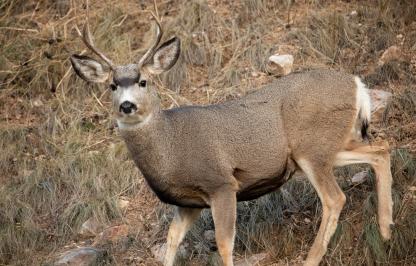In early March, the Wyoming Game and Fish Department, along with several partners, began a three-year study of mule deer in the northern Bighorn Mountains. This study is the first of its kind in this area.
Mule deer are an iconic big game animal and though it varies by region, populations in much of Wyoming and the West have been declining for decades.
“We have very little data on the overall health of this mule deer herd,” said Dayton Game Warden Dustin Shorma. “It is difficult to understand the population dynamics of these deer because during the optimum time to conduct classification counts, they have already moved off the mountain and mixed in with resident mule deer living along the foothills. Not only can we not differentiate which deer summered on the mountain and which didn’t, on the east face of the mountain the high resident deer densities dilute any warning signs - like low fawn numbers or low yearling buck numbers - we would observe during post-season ground surveys.”
Game and Fish wildlife managers have historically conducted mule deer classification surveys each year in November and December. In 2018, pre-hunting season surveys were also initiated on the Bighorn National Forest to identify summer distribution and composition of the animals before these deer move to lower elevations in the fall.
To gather information about this herd, a collaborative project was developed in 2019 between Wyoming Game and Fish, The Nature Conservancy, Sheridan Community Land Trust, the Bighorn National Forest, the Wyoming Migration Initiative and the University of Wyoming Cooperative Fish and Wildlife Research Unit. The study is designed to identify mule deer movements in the northern Bighorns, evaluate seasonal range and habitat use and document fawn production and three-to-six month fawn survival rates. This information will be gathered using data from GPS collars placed on mule deer does and on-the-ground observations.
On March 5, 25 does were captured and fitted with the collars by a professional wildlife capture crew -10 on the east side of the mountain and 15 on the west side. On the western slope of the Bighorns, all captures were conducted on public land. On the eastern side, all captures were done on private land with the gracious cooperation of several local landowners. Further captures in coming months will increase the final number of collared does to 90.
The GPS collars will record the position of each animal every two hours for the next three years. At the end of the three years, the collars will automatically release from the animal. Once-daily position updates will be available to biologists throughout the study, while the finer-scale, two-hour movements will be stored onboard the collar and retrieved at the end of the study.
If an animal dies during the study, a mortality signal will be sent to the local wildlife biologist who will search for the animal’s carcass to retrieve the collar, determine the cause of death and collect biological samples.
One of the collared does on the east side of the Bighorns has already died. Sheridan Wildlife Biologist Tim Thomas received a notification from the collar of mule deer doe #3 on March 27 that the animal had not moved in several hours. The next day, Thomas and other personnel searched the area of the last recorded location and found the carcass. Evidence at the scene suggests a mountain lion killed the deer. The collar was retrieved intact and its stored data will be downloaded. It will be placed on another deer during the next capture operation.
Data from the study will be used to identify future habitat and conservation opportunities, inform forest planning, identify areas where wildlife-friendly fences may be beneficial and potentially make modifications to hunting season structure. Information from the study could also inform potential transmission risks for chronic wasting disease in this herd.
To date, the project has received generous financial support from the Knobloch Family Foundation, the Mule Deer Foundation, The Nature Conservancy, Sheridan Community Land Trust, the Wyoming Game and Fish Department, the Department of the Interior Secretarial Order 3362 and the Cody Chapter of Muley Fanatics. Additional funding opportunities are being sought as the project progresses and regular updates will be provided to donors and the public.
Northern Bighorns Mule Deer Study Begins
3076727418



